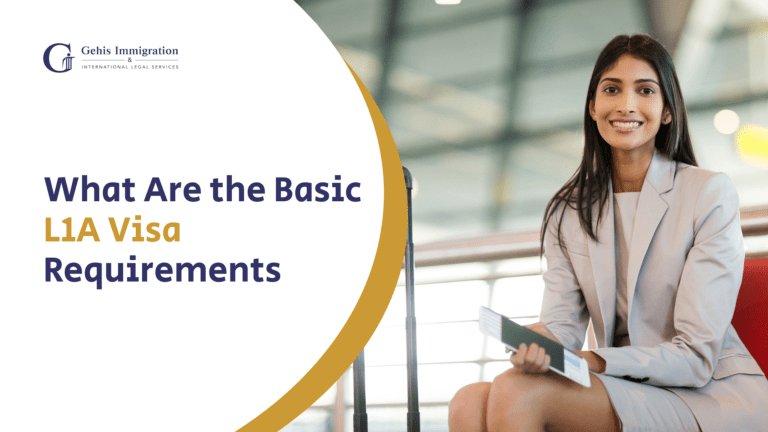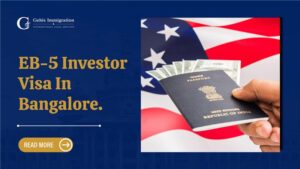The L1A visa is a non-immigrant visa category that allows multinational companies to transfer managers or executives from their foreign offices to the United States. This visa is specifically designed to facilitate intra-company transfers and promote the efficient functioning of multinational corporations. L1A visa allows companies to transfer key personnel for managing operations, ensuring coordination between parent and U.S. branches.
The L1A visa falls under the broader category of L1 visas, divided into L1A for managers and executives and L1B for employees with specialised knowledge. The L1A visa is intended for individuals in leadership roles within the organisation. Applicants for an L1A visa need one year of continuous employment with the foreign company and must work in a managerial or executive role in the U.S.
What are the Eligibility Criteria For an L1A Visa?
For an L1A visa, the foreign company needs a valid link with its U.S. branch, subsidiary, affiliate, or joint venture.
Companies commonly use the L1A visa to transfer executives or managers between a foreign parent company and a U.S. subsidiary. Demonstrating the parent-subsidiary relationship establishes the required connection, often through ownership and control structures.
Apart from the parent-subsidiary relationship, affiliated companies under common ownership can also qualify for the L1A visa. Scenarios where foreign and U.S. entities are subsidiaries of the same parent company or are otherwise affiliated through shared ownership include.
Applicants must work for the foreign company for one year within three years before applying for the L1A visa.
L1A visa applicants must seek to enter the U.S. to work in a managerial or executive capacity. A managerial role involves overseeing the work of other supervisory, professional, or managerial employees or managing an essential function within the organisation. An executive role typically involves directing the organisation’s management or a major component or function.
Applicants need one year of continuous managerial or executive experience within three years before filing the L1A petition. This employment duration is an important factor in establishing the applicant’s eligibility for the visa.
What Is the Duration and Extension of an L1A Visa?
The initial duration of an L1A visa typically grants one year for new office petitions and up to three years for existing offices. Managers and executives can extend their stay to seven years, including any extensions, while specialised knowledge employees under the L1B category are usually limited to five years.
The L1A visa is a dual intent visa, permitting holders to aim for permanent residency (green card) in the U.S. while on a non-immigrant visa. This feature provides flexibility for L1A visa holders who may transition to permanent residency in the U.S.
For an L1A visa extension, the applicant must still meet criteria like the U.S.-foreign company relationship, managerial or executive position, and required employment duration with the foreign company. The extension petition should demonstrate that the individual remains essential to the efficient operation of the U.S. business.
Extensions for L1A visa holders
L1A visa holders generally receive extensions in increments of up to two years. L1A visa holders, including extensions, can stay up to seven years. After reaching this limit, they need to spend one year outside the U.S. before being eligible for a new stay.
Extending an L1A visa requires submitting a new petition to USCIS by the employer. They must show the ongoing need for the individual in a managerial or executive role and maintain compliance with L1A visa rules.
Extensions beyond the maximum allowable period may be possible through changing status to another visa category or pursuing permanent residency. L1A visa holders with one year of status may qualify for the EB-1C immigrant visa for managers and executives.
What Are The Documentation Requirements For an L1-A Visa?
The first step in applying for an L1A visa is filing a Petition for a Nonimmigrant Worker with the United States Citizenship and Immigration Services (USCIS). The U.S. employer should submit the form on behalf of the prospective L1A visa holder. The petition serves as a request to classify the beneficiary as an intracompany transferee in a managerial or executive capacity.
The petitioner must provide a thorough set of supporting documents to prove the applicant’s eligibility and the U.S.-foreign company relationship. This includes documentation of the applicant’s employment history, the managerial or executive role, and evidence supporting the qualifying relationship.
The petitioner must submit organizational charts, articles of incorporation, and corporate documents showing the legal relationship between entities. This helps establish the qualifying relationship, such as parent-subsidiary or affiliation under common ownership.
Petitioner has to include financial statements, annual reports, or other financial documentation that illustrates the financial ties and interconnectedness between the U.S. and foreign companies.
Petitioner has to provide a detailed job description outlining the managerial or executive duties the applicant will be responsible for in the U.S. This should highlight the strategic and high-level nature of the position.
Petitioner has to submit organisational charts that clearly illustrate the managerial or executive position within the company’s hierarchy. This helps demonstrate the applicant’s role in overseeing other employees or managing essential functions.
L1A applicants seeking to open a new office in the U.S.
must provide a comprehensive business plan outlining the nature of the business, its operations, and the proposed organisational structure.
Incorporate financial forecasts showing funding sources, expected performance, and how U.S. operations will boost organizational growth and success.
Present a timeline with milestones for establishing and growing the new office. This can help demonstrate the feasibility and viability of the U.S. operations.
It is essential to verify that all documentation is well-organized, current and meets the eligibility requirements for the L1A visa. Working with knowledgeable immigration professionals for L1 visas simplifies the process and enhances approval likelihood.
Final Word
Getting help from immigration experts like lawyers or consultants familiar with U.S. immigration law is crucial for the intricate L1A visa process. Their guidance ensures meeting all requirements, accurate documentation, and improves approval chances.
Understanding and meeting L1A visa requirements helps applicants and employers smoothly navigate intra-company transfers, benefiting multinational corporations in the U.S.






